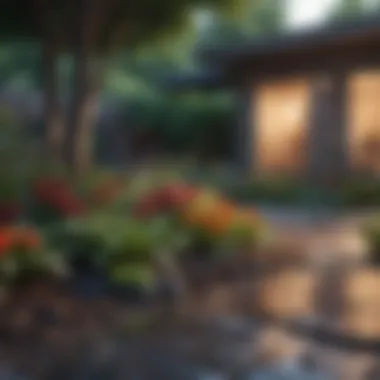Comprehensive Guide to Pricing for Landscaping Jobs


Intro
Determining the costs associated with landscaping jobs involves multiple factors. Understanding these factors can lead to better budgeting, more realistic expectations, and ultimately, satisfaction with the work done. Accurate pricing not only helps homeowners to allocate their funds wisely but also empowers landscaping professionals to present fair estimates.
In this guide, we will explore the dynamics of pricing in landscaping. From labor to materials, from seasonal changes to project complexities—each element contributes to a broader financial landscape. The goal is to provide a structured approach to understanding these costs, aiding both homeowners and landscaping professionals in making informed decisions.
Key Points to Discuss
- The impact of labor costs on overall pricing
- The significance of material choice in budget preparation
- Variations in costs due to market factors and project complexity
- Practical guidance for deriving accurate estimates
- Insights into pricing models used in landscaping
Through this detailed exploration, we aim to demystify the often opaque nature of landscaping costs. Homeowners looking to improve their outdoor spaces and landscaping professionals aiming to provide precise estimates can benefit from the insights detailed herein. This article serves as a crucial resource to navigate the financial aspects of landscaping projects.
Prologue to Landscaping Pricing
Landscaping pricing is an essential aspect of the overall landscaping industry. A thorough understanding of pricing strategies allows both homeowners and landscaping professionals to navigate the complexities of budgeting effectively. This section highlights key factors influencing costs, ensuring informed decision-making for all parties involved. Whether it is determining project expenses or evaluating labor requirements, accurate pricing lays the foundation for successful landscaping outcomes.
Understanding the Importance of Accurate Pricing
Accurate pricing is crucial for several reasons. Firstly, it ensures that landscaping professionals can cover their costs while also making a profit. An overly low estimate can lead to financial losses, while a high quote may deter potential clients.
For homeowners, knowing the correct price range helps in budgeting for projects and prevents overextending financially. It creates transparency in the contractor-client relationship, fostering trust. Accurate pricing ultimately enhances satisfaction on both sides, providing value for service rendered.
In addition, accurate pricing assists in project planning. When all costs are clear, project timelines and execution strategies can be developed more efficiently. This clarity helps avoid disputes or misunderstandings later on, making the overall process smoother.
Factors Influencing Landscape Job Costs
Several factors significantly influence the costs associated with landscaping jobs. Understanding these factors can help in managing expectations and preparing budgets well.
- Labor Costs: One of the largest expenses in landscaping projects stems from labor. The skill level required for specific tasks directly impacts costs. Hiring experienced landscapers or specialists increases labor costs due to higher wages.
- Materials and Supplies: The choice of materials can affect prices. Premium materials like natural stones or high-quality plants increase project costs, whereas more budget-friendly options can save money. Additionally, local supply availability can cause fluctuations in costs.
- Project Complexity: The intricacy of a landscaping design directly correlates to its cost. Simpler projects such as basic lawn care may require less investment compared to complex installations like intricate garden designs or pond construction.
- Location: Regional differences can influence pricing. Urban areas may experience higher cost structures compared to rural locations due to demand and local economic conditions.
- Seasonality: Landscaping prices can vary with the seasons. Certain times of the year may see increased demand, driving prices higher, while off-peak seasons may offer lower rates due to reduced project activity.
Accurate pricing integrates various factors leading to a smoother transaction and project execution.
In summary, understanding the factors influencing landscaping costs will provide a clearer picture for homeowners and professionals alike. By considering these components, both parties can engage in more fruitful discussions, ensuring successful project outcomes.
Key Components of Pricing for Landscaping Jobs
Understanding the key components of pricing for landscaping jobs is essential for both contractors and clients. This section explores the elements that typically determine the final cost of a landscaping project. Accurate knowledge of these components allows for better financial planning and expectations. Each part plays a crucial role in shaping the overall price tag of the services rendered.
Labor Costs
Labor costs represent a significant portion of landscaping expenses. These costs vary based on multiple factors, including the complexity of the job, the expertise required, and regional wage differences. For instance, seasoned professionals command higher rates due to their skill set and experience.
When estimating labor costs, consider the following aspects:
- Type of Work: Basic tasks like mowing may cost less compared to intricate installation work involving pathways and lighting.
- Crew Size: A larger crew can complete jobs quicker but may raise the overall labor cost. It’s important to evaluate both the size and efficiency of the team.
- Time of Year: Seasons can affect labor availability and pricing. For example, peak season may require paying overtime for workers.
Being clear about the expected duration of the project can assist homeowners in understanding the labor costs more thoroughly.
Materials and Supplies
The cost of materials and supplies is another crucial element in landscaping pricing. This category includes everything from soil and grass to decorative elements like stones and plants. The type of materials selected can greatly influence the overall budget.


Important considerations include:
- Quality of Materials: High-quality materials often carry a higher initial cost but can result in lower maintenance expenses and greater longevity.
- Sourcing: Local suppliers may offer better prices and faster service than distant ones. Assessing multiple sources can yield better deals.
- Environmental Sustainability: Eco-friendly materials might be more expensive initially, but they can add value over time by reducing environmental impact.
Taken together, these factors not only contribute to the cost but also impact the final aesthetic and functionality of the landscape.
Equipment Usage and Rental
The costs associated with equipment usage and rental represent another component in the pricing equation. Depending on the scale of the job, the tools required can range from basic hand tools to advanced machinery.
Key points to consider:
- Type of Equipment: Certain projects may require specialized equipment, adding to the overall expenses. For example, larger equipment needed for grading may not be necessary for simpler tasks.
- Rental Costs: For jobs that don't justify the purchase of equipment, renting can be a cost-effective solution. However, rental fees need to be factored into the overall pricing.
- Maintenance and Fuel Costs: When equipment is used, maintenance and fuel costs can add up. It's essential to incorporate these expenses into the final price presented to the client.
Market Factors Affecting Landscaping Prices
Understanding market factors that affect landscaping prices is crucial for both homeowners and professionals in the landscape industry. These factors determine not only the cost of services but also the economic viability of landscaping projects. The ever-changing conditions in the marketplace, influenced by various economic and environmental elements, require careful consideration when estimating job costs.
Regional Pricing Variability
Regional pricing variability plays a significant role in determining landscaping rates. Different areas have distinct economic conditions, labor costs, and local standards that impact pricing. For instance, a landscaping job in a metropolitan area like San Francisco may cost significantly more than a similar project in a rural setting. This difference is influenced by several aspects:
- Cost of Living: Urban areas tend to have higher living costs, which translates to higher wages for workers.
- Competition: The level of competition among landscaping providers can drive prices down in some regions while others may have monopolies that inflate costs.
- Local Regulations: Areas with strict zoning laws may require additional permits, raising project costs.
It is beneficial for clients to research local prices before committing to any landscaping work. Accurate geographical knowledge helps avoid sticker shock and ensures a fair assessment of project budgets.
Seasonal Trends in Landscaping Costs
The seasonality of landscaping services significantly affects pricing. Different times of the year bring varying demands for landscaping projects. Understanding these trends can help manage expectations and costs:
- Spring Surge: As winter fades, many homeowners look to rejuvenate their outdoor spaces. This peak season can lead to increased demand and, consequently, higher rates for services.
- Fall Preparation: Fall is an essential time for preparation leading into winter. Services like lawn aeration are sought after, often at competitive prices due to the number of providers.
- Off-Peak Costs: In winter or extreme heat, there may be a drop in demand, leading to decreased rates as companies seek volume to maintain revenue.
Analyzing these seasonal trends allows homeowners and professionals alike to strategize their landscaping efforts more effectively, choosing the best times for service engagement to optimize their investment.
"Understanding local market factors and seasonal trends can significantly enhance budgeting accuracy for landscaping projects."
By taking these market factors into account, individuals can make informed decisions that ultimately contribute to more successful landscaping ventures.
Types of Landscaping Projects and Their Cost Implications
Understanding the types of landscaping projects is crucial for determining their cost implications. This section emphasizes how varying project types can lead to different pricing structures. Homeowners should recognize that each project type—ranging from basic tasks to intricate installations—carries unique demands on resources, expertise, and time.
Basic Lawn Care Services
Basic lawn care services typically include mowing, edging, fertilization, and weed control. These services are vital for maintaining the health and appearance of residential lawns. The costs associated with these services are generally predictable. Factors influencing the pricing of basic lawn care include:
- Size of Lawn: Larger areas naturally require more time and resources.
- Service Frequency: Regular services may have a lower per-visit charge compared to one-time services.
- Type of Grass: Different grass types require varying care, which can affect costs.
Typically, homeowners can expect to pay between $30 to $80 per visit for basic lawn care, depending on these variables. Understanding these cost factors can help homeowners budget effectively for routine maintenance.
Complex Design Installations
Complex design installations refer to projects that transform outdoor spaces through elements like patios, pathways, gardens, and water features. This type of project is more intricate and demands more skilled labor, higher material costs, and detailed planning. When evaluating the costs of complex designs, consider the following:


- Design Complexity: Unique designs often require custom solutions, raising overall costs.
- Material Selection: Costs can vary widely based on whether you choose natural stone, concrete, or synthetic materials.
- Labor Expertise: Skilled tradespeople can command higher wages for their specialized services.
For many homeowners, these installations can range from $1,500 to over $10,000, influenced significantly by the scope and details of the design. Understanding these elements can lead to more accurate project budgets.
Maintenance Services
Maintenance services encompass a wide range of ongoing support to keep landscapes healthy and appealing. This includes seasonal clean-up, mulching, planting, and irrigation system checks. The pricing of these services is often influenced by:
- Frequency of Service: More frequent maintenance can sometimes reduce the cost per visit.
- Seasonal Adjustments: Costs may rise during peak seasons when demand increases.
- Specific Plants or Features: Certain plant types or features may require specialized care, impacting costs.
Homeowners should be prepared for maintenance costs that can vary based on the services selected and the landscape's condition. A typical range for these services is from $200 to $1,500 annually, depending on the complexity and upkeep needs.
Understanding the specific types of landscaping projects and their financial implications is essential for managing expectations and achieving desired outcomes.
Estimating Costs for Landscaping Jobs
Estimating costs accurately for landscaping jobs is crucial for both homeowners and landscaping professionals. This process ensures that all parties involved have a clear understanding of the financial commitments required for a project. Accurate estimates provide a solid foundation for budgeting, which can prevent disputes and misunderstandings later on. Clients appreciate transparency, and detailed estimations can promote trust in the contractor's expertise.
Several key elements contribute to effective estimating. Understanding the client’s needs, assessing the site conditions, and applying industry standards all play significant roles. Failure to address these components can lead to unexpected costs and project delays.
Moreover, proper estimating allows for a systematic approach to project management. It helps in allocating resources efficiently, thus maximizing potential profitability. A comprehensive estimate also assists in benchmarking against industry norms, which can further refine pricing strategies.
Accurate cost estimation is not merely a number crunch; it requires a blend of skill, intuition, and knowledge of the landscaping industry.
Gathering Client Needs
Gathering client needs is the first step in estimating costs for landscaping jobs. This involves having a detailed conversation with the client to understand their vision, preferences, and budget constraints. Listening carefully to their ideas ensures that the final proposal aligns with their expectations.
To facilitate this process, it can be beneficial to ask specific questions:
- What is the primary purpose of the landscaping project?
- Are there any specific features they want to include, such as patios, gardens, or water features?
- What kind of maintenance are they willing to undertake?
This dialogue aids in determining the scope of work and identifying any unique challenges that may arise during the project. Clear communication at this stage sets the tone for successful project execution.
Site Assessments for Accurate Pricing
Conducting site assessments is vital for accurate pricing. This involves visiting the location to evaluate physical conditions that influence costs. Several factors need assessment:
- Soil Quality: The soil composition can significantly affect planting choices and overall costs. Poor soil may require amendments or additional preparation.
- Slope and Drainage: Understanding the topography helps to plan appropriate landscaping solutions that prevent issues such as erosion.
- Existing Vegetation: Noting any existing trees or plants can reduce costs if they can be integrated into the new design.
Accurate measurements and observations during site assessments help in formulating reliable estimates. For example, determining area sizes for planting or turf installation requires precise data. This groundwork ultimately leads to a more competitive and justified pricing structure.
Utilizing Industry Standards for Estimates
Using industry standards is essential in creating accurate estimates. This means referring to established pricing guides and cost databases that reflect current market conditions. These resources can help landscapers to benchmark their estimates against the broader market, providing a context for their quotes.
Incorporating industry standards benefits estimating in several ways:
- It helps to ensure that prices remain competitive.
- It provides a framework for justifying costs to clients.
- It encourages consistency across estimates for different projects.
Landscape professionals can leverage resources like the American Society of Landscape Architects or local industry associations to stay updated. Utilizing these standards ensures that no crucial element is overlooked in the pricing process.


Different Pricing Models in Landscaping
Pricing models in landscaping are essential for both service providers and clients. These models establish how labor and material costs are calculated, influencing profitability and budget planning. Understanding the variety of pricing structures allows homeowners and landscaping professionals to navigate financial conversations more effectively. Many elements play a role in determining the best pricing model for a job, such as project complexity, client preferences, and market demands. Choosing the right pricing model can foster transparent discussions, accurately reflect project scope, and lead to fair compensation.
Hourly Billing
Hourly billing is a common pricing model in landscaping, especially for smaller tasks or projects where the scope is not clearly defined. This method involves charging clients based on the actual time spent on the job. While this model can be beneficial, it also comes with its own considerations. For clients, it provides flexibility, as they can scale services based on their needs. Service providers can charge for every hour they work, ensuring they receive fair pay for their time. However, clients may feel uncertain about overall costs as hours can vary significantly based on project challenges or unforeseen conditions. To foster trust, clear communication regarding estimated timeframes is crucial.
Flat Rate Pricing
Flat rate pricing offers a clear and fixed price for a landscaping project, regardless of the time or resources dedicated to its completion. This model benefits both clients and service providers by reducing ambiguity. Homeowners can budget effectively, knowing the total cost upfront. For landscape professionals, it simplifies pricing and can increase efficiency, motivating them to complete jobs promptly. However, estimating the total costs accurately is essential to avoid underpricing, which can lead to losses. Flat rate pricing is advantageous for well-defined projects like lawn installations or garden designs, where variables are minimal and easier to estimate.
Per Square Foot Pricing
Per square foot pricing is often employed for landscaping installations that cover a large area. This model measures project cost based on the square footage that needs to be landscaped. It is particularly popular for lawn installations, paving, or planting beds. Clients appreciate the straightforwardness of this method, providing clarity on how costs correlate to the size of their project. Landscape professionals can easily calculate estimates by measuring the area and applying a per-square-foot rate. However, it is essential to keep in mind that this pricing structure may not encompass other necessary services like site preparation or maintenance.
"Choosing the right pricing model in landscaping is not just about the bottom line; it is about ensuring both service providers and homeowners feel satisfied and respected in their agreements."
Communicating Pricing with Clients
Effective communication of pricing is a critical aspect of any landscaping job. For both homeowners and professionals in the industry, clarity in pricing can determine the success of projects. It is crucial to discuss costs openly to prevent misunderstandings later. Clients appreciate knowing exactly where their money goes, which fosters trust and builds a solid relationship.
Moreover, discussing pricing upfront allows clients to assess their budget correctly. This also helps contractors understand the client’s financial constraints and expectations. In the long run, clear communication can lead to smoother project execution and fewer conflicts.
Transparency in Pricing
Transparency in pricing refers to being open about how costs are calculated and what clients can expect. This involves detailing labor costs, material expenses, and other potential fees.
- Breakdown of Costs: Providing a detailed breakdown allows clients to see how their investment is allocated. For instance, indicating specific costs for plants, soil, and labor can help clients perceive value in your services.
- Open Dialog: Encouraging questions about pricing builds rapport with clients. A straightforward discussion about why certain materials are priced as they are can alleviate concerns about inflated costs.
- Avoiding Surprises: Unanticipated expenses can lead to client dissatisfaction. By being upfront about potential additional costs—like permits, disposal fees, or unexpected site conditions—you set realistic expectations.
Transparency not only reinforces your professionalism but can distinguish your business in a competitive market.
Documenting Estimates and Invoices
Documenting estimates and invoices is part of best practices for communicating pricing. An accurate paper trail can protect both the contractor and the client. Without proper documentation, misunderstandings can arise, leading to disputes.
- Formal Estimates: Always provide clients with a formal estimate that details scope, costs, and timelines. Having a written basis for your agreement helps manage expectations.
- Clear Invoices: When the job is completed, deliver a clear, itemized invoice. Highlight any variations from the original estimate so that clients can see what changed and why.
- Record-Keeping: Maintain copies of all estimates and invoices for your records as well. This serves as a safeguard should any discrepancies come up in the future.
"Clear communication is not just about the price; it’s a philosophy that influences the entire project outcome."
By adhering to these principles, landscaping professionals can ensure a more respectful and effective collaboration with clients.
Culmination: The Landscape of Pricing Strategy
Understanding the intricacies of pricing strategies in landscaping is vital for both professionals and clients. This final section synthesizes key takeaways from previous discussions. It emphasizes how effective pricing can directly affect profitability and customer satisfaction. By grasping the principles laid out in this guide, stakeholders can strike a balance between competitive pricing and maintaining high-quality services.
Strategically pricing landscaping jobs involves several factors. These are labor costs, material expenses, and equipment fees. Each element plays a critical role in determining the overall cost of a project. Thus, recognizing their influence can facilitate informed budgeting and enhance the decision-making process.
Moreover, market factors such as regional pricing variability and seasonal trends significantly impact pricing strategies. Landscaping professionals must continuously adapt to these dynamics to remain competitive. For homeowners, understanding these variables can lead to more meaningful discussions with contractors, ultimately leading to better outcomes in their landscaping investments.
By leveraging different pricing models, such as hourly billing, flat rate pricing, or per square foot pricing, professionals can cater to a wider range of customer needs. This creates opportunities to optimize job structures and improve business profitability.
Final Thoughts on Pricing for Profitability
Ultimately, implementing a well-defined pricing strategy not only ensures profitability but also fosters trust between landscape contractors and clients. Transparent communication about costs and detailed documentation of estimates and invoices are fundamental parts of this process. Both parties benefit when pricing clarity is maintained, which contributes to long-term relationships and repeat business.
In the landscaping industry, a nuanced understanding of pricing can differentiate between success and failure.
To sum it up, as the landscaping market evolves, staying informed and adaptable is key. Professionals should regularly reassess their pricing strategies to best fit the changing landscape of their business environment. By adopting the principles discussed in this guide, landscaping service providers can navigate the complexities of pricing with confidence and efficiency.







